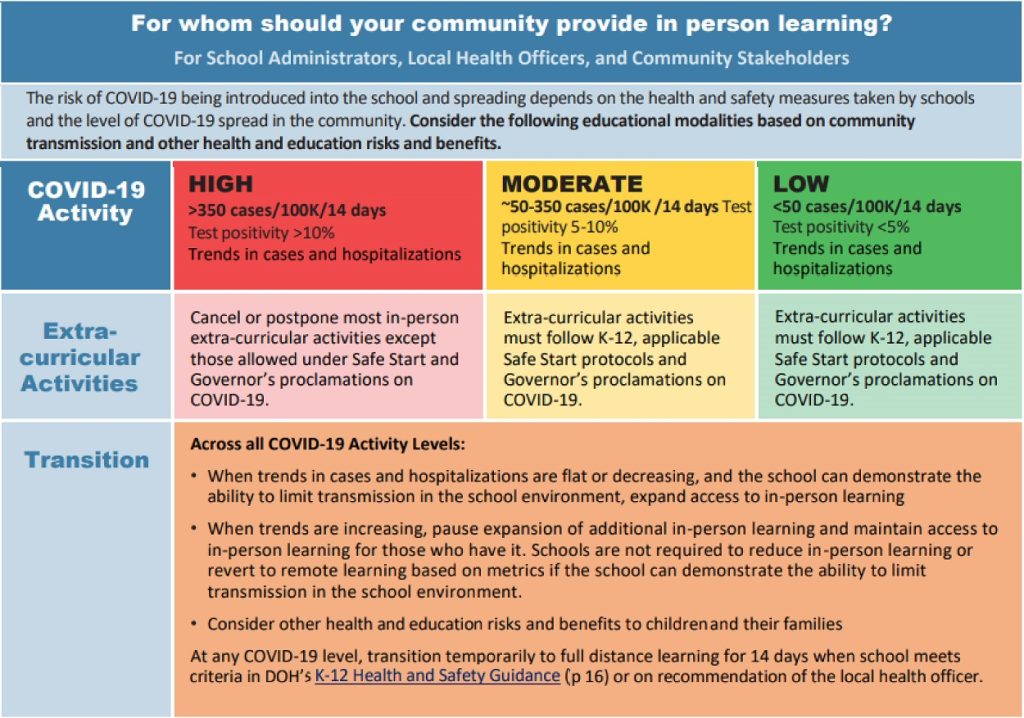By Office of the Governor
- $3 million from set aside funds to be distributed to implement health and safety protocols
- In-person learning resumes at less than 50 COVID cases per 100,000 in county
- Phase-in In-person learning resumes at less than or equal to 350 COVID cases per 100,000 in county
- Phase-in groups of no more than 15 students for pre-K through 5 and those with special needs resumes at greater than 350 COVID cases per 100,000 in county
- Each school must have an operational safety committee responsible for a COVID-19 prevention plan
- In school Department of Labor & Industries point of contact
- Greater than 350 COVID cases per 100,000 in county: Cancel or postpone most in-person extra-curricular activities except those allowed under Safe Start and Governor’s proclamations on COVID-19.
- Less than or equal to 350 COVID cases per 100,000: Extra-curricular activities must follow K-12, applicable Safe Start protocols and Governor’s proclamations on COVID-19
- Less than 50 COVID cases per 100,000: Extra-curricular activities must follow K-12, applicable Safe Start protocols and Governor’s proclamations on COVID-19
Gov. Jay Inslee and Superintendent of Public Instruction Chris Reykdal today announced an update in the metrics used to inform local school district decisions for in-person learning. They also announced $3 million from set aside funds to be distributed to implement health and safety protocols.
Related to safety in schools, the governor will issue an accompanying proclamation requiring schools by law to implement health and safety measures, and mandates staff involvement in health and safety related decisions.
“I have sought the opinions of state and local education administrators, as well as educators, staff, parents and school boards. And today, we are providing them more clarity and confidence in getting students back in the classroom,” Inslee said during a press conference Wednesday. “Many people’s lives revolve around a regular school schedule and, apart from the academics, schools provide social supports that advance healthy childhood development.”
School Health and Safety Toolkit
The update to in-person instruction guidance comes after recent data showed limited COVID-19 transmission in school environments when state health and safety protocols are implemented.
National experts from MIT, Brown University and Harvard, along with experts in Washington have shown a dramatic drop in risk of infection transmission when safety measures are in place, such as masking, physical distancing, and increased ventilation and environmental cleaning.

Dr. Danielle Zerr, medical director of infection prevention and chief of pediatric infectious diseases for Seattle Children’s Hospital, said that while data is still being collected on susceptibility of school-aged children, there is a lack of evidence that schools are a significant source of transmission.
“We have learned critical lessons from schools that have already opened about how to support teachers and school personnel,” Zerr said. “Though nothing is without risk, kids can be brought back to school in person safely through careful preparation and thoughtful sequencing appropriate to disease burden in the community, age of the students and other considerations.”

The Department of Health suggests three categories for re-introducing in-person learning:
- For schools in counties where COVID-19 cases are “low” (less than 50 residents per 100,000), in-person learning should be made available for all students.
- In counties where COVID-19 cases are “moderate” (between 50 and 350 residents per 100,000), in-person learning should be phased in, starting with elementary students not already attending in person and middle school students, followed by high school students.
- Finally, in counties where COVID-19 cases are “high” (over 350,000 per 100,000 residents), it’s recommended that schools should only offer in-person instruction for elementary and high-need students in small groups of 15 students or fewer.

Each school must have an operational safety committee responsible for a COVID-19 prevention plan. These plans must include a designated COVID-19 supervisor, training off all staff on COVID-19 prevention, and adequate supply and distribution of Personal Protective Equipment, including respiratory protection.
The Department of Labor & Industries will designate a single point of contact to serve as a liaison for school workplace safety and concerns to ensure confidence in the community that schools are adhering to safety protocols.
Additional funding for health and safety
The governor also announced $3 million from set aside funds that he will direct to OSPI to support health and safety work in Washington schools. This money will help fund third-party safety audits and support the staff in districts in need for more financial support in meeting safety requirements.
Superintendent Reykdal said this funding is much needed to get students back into schools safely and that this move toward in-person learning will help students succeed.
“Our state has some of the most stringent health and safety protocols for schools in the nation, and those are working to limit the spread of the virus in our schools,” Reykdal said. “Most students do best in the traditional in-person school environment with their peers and educators. With the science and data showing us we can do this safely, I am confident we should begin moving more of our students back to the physical classroom.”
School testing
The Department of Health also released guidance Wednesday to expand access to testing for K-12 schools as in-person learning begins to be phased-in. The guidance will help local school and health leaders determine who, how and when to test or screen their students and staff in the K-12 school environment.
Twelve Washington school districts are already participating in a School Testing Pilot, with several others planning to join and start in-person in January.
“Our teachers and school administrators have done a phenomenal job navigating unprecedented challenges,” Inslee said. “This updated guidance provides a framework and will help schools plan and prepare so that when the metrics reach the appropriate level, they’re able to resume in-person instruction quickly and safely.”
Read the full in-person guidance here.
Read the full testing guidance here.



















